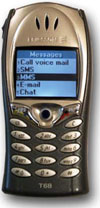MMS (Multimedia Messaging Service) explained
14 January 2002 You have probably heard of MMS (Multimedia Messaging Service), the next generation of SMS (Short Messaging Service) that will be included in the next firmware upgrade of the Ericsson T68 mobile phone. This article will try to explain what MMS is.  MMS is specified by both 3GPP (3G Partnership Project) and WAP Forum. Phone manufactures like SonyEricsson, Nokia, Motorola and Siemens are all member of WAP forum and they will all produce phones with MMS support by the end of 2002. MMS is specified by both 3GPP (3G Partnership Project) and WAP Forum. Phone manufactures like SonyEricsson, Nokia, Motorola and Siemens are all member of WAP forum and they will all produce phones with MMS support by the end of 2002.
Like SMS, MMS is a messaging service, which means that you send and receive messages to/from a mobile phone. A SMS can only consist of image and/or text, while in MMS you will be able to send and receive text, images (GIF, JPEG), sound (MP3, MIDI, WAV), email and video (MPEG 4). Like with SMS, end users are provided with the possibility to request delivery report of the sent message as well as setting the message's maximum lifetime. The receiver of a MMS message is notified of the incoming message with an MMS notification using SMS as a bearer. A MMS message is build up of several media files described in a XML (Extensible Markup Language) document. The XML document is of the type SMIL (Synchronized Multimedia Integration Language). SMIL enables simple authoring of interactive audiovisual presentations. SMIL is typically used for "rich media"/multimedia presentations which integrate streaming audio and video with images, text or any other media type. A typical MMS message will behave almost like a PowerPoint presentation with background sound added. The first phones with MMS uses a version of SMIL that are able to present a slideshow with maximum 2 screen areas per slide plus a background sound. The MMS media files are downloaded to the phone via GPRS (General Packet Radio Service). The low GPRS transfer speed will limit the type of message that you are able to send and receive. It's not practical to send an MMS video with the GPRS maximum 56Kb speed limit but UMTS will be able to deliver data rates up to 2Mbit/s, which should be fast enough for video clips. You can think of a MMS message as an email with attachments. In an email, the attachments are not seen before you click on them. In a MMS message the "attachments" are not downloaded to the phone before you open the message.
When someone sends an MMS to a non-MMS phone - you still get the message. An SMS notifies you of its arrival with a link to a website. Just click on the site on your PC and the message will be waiting for you. If you have a WAP phone you can go straight to the site and pick up your message wherever you are, and if you have a WAP phone the MMS is delivered directly to your screen. Since MMS support CC (carbon copy) and BC (blind copy) you will be able to send the same message to multiple recipients. You only send one copy of the MMS but it is distributed to every receiver in your CC-list by the MMC (Mobile Messaging Center). What the cost of sending and receiving a MMS will be is uncertain, but it will probably be a combination of today's SMS (per message) and the size of the message sent/received. I.e.: you will pay a fixed price for the notification of a new message plus the cost for the number of bytes sent or received. The first services made for MMS will probably be sending and receiving of logos and ring tones like the popular SMS services we have today. Other services could be (paid?) subscriptions to weather and traffic reports, cartoons and your favourite news service. The soon to be released Nokia 7650 has a build in camera, and any Ericsson with CommuniCam will be able to take a picture and use MMS to send it to friends and family. Owners of Ericsson's T68 can upgrade their phone software with MMS support for free at a Ericsson service centre. The MMS upgraded will probably be available in week 10 2002. Contact Ericsson for more information about the release date.
|








 RSS feed
RSS feed